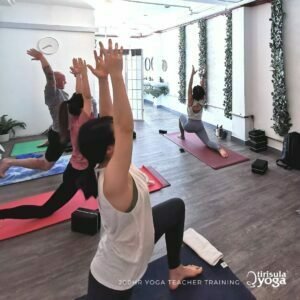Asana is one limb of yoga and it’s the physical aspect of it. Asana is defined as bringing the body in a comfortable pose or position. Doing the yoga asanas involve our whole being, the breath, focus and body. Our physical body is a complex structure and one of its complexities is a joint. A joint is the part of the body where two or more bones meet to allow movement. Every bone in the body – except for the hyoid bone in the throat – meets up with at least one other bone at a joint. The shape of a joint depends on its function.
Hip joint is one of the largest weight bearing joint of the body. It’s where the upper part of the body meets the lower part. The hip is a ball and socket joint which consists of the femoral head, a ball-shaped piece of bone located at the top of the thigh bone or femur, and acetabulum, a socket in the pelvis into which the femoral head fits. The ligaments connect the ball to the socket, stabilising the hip and forming the joint capsule. A thin membrane called synovium lined the joint socket and act as lubricant for the joint while bursae the fluid-filled sacs provide cushioning for the friction between muscle, tendons and bones.
Different types of movement is possible for the hip because it’s a ball and socket joint. The hip is capable of flexion, extension, abduction, adduction, external rotation, internal rotation and circumduction. In order for these actions to take place different muscle groups are required. There is a prime mover or the main driver of the action, synergist or the helper or stabiliser of the action and the antagonist or the opposing force producer which in turn aid in controlling the motion.
Flexion is one movement the hip joint can do and it is when you bring the leg or lower part of the body closer to trunk. The biggest muscle for flexing the hip joint is iliopsoas (consisting of Psoas Major and Iliacus). Sedentary lifestyle as well as sports like running and jumping can cause this muscle to become tight and thus weaken. Stretches are necessary to lengthen back the shortened muscle. One yoga pose to stretch this muscle is the low lunge or anjaneyasana. In low lunge, the hip flexors of the back leg are stretched while the gluteus muscles of the back leg and the quadriceps of the front leg are strengthened.

How to low lunge:
- Begin in Downward-Facing Dog or Adho Mukha Svanasana. On an exhale, step your right foot forward between your hands.
- Lower down onto your left knee and release the top of the left foot on the ground.
- Ensure that the right knee is stacked directly over the right ankle, and isn’t moving forward toward the toes or outward to the left or right (this protects the knee from injury). Keep the knee directly over the ankle if it feels like enough for your body—you should feel a comfortable stretch along the left front thigh and groin. For a deeper sensation, you can inch the right foot forward on the mat until you find an edge that feels appropriate for your body.
- Take your fingertips to the ground on either side of your hips (you can also rest both hands on the front knee if taking the fingertips down feels like too much) and relax your shoulders away from your ears. As you continue to breathe deeply, soften the weight of your body down into your hips, and draw your tailbone down toward the ground.
- Feel free to remain here, with your hands on your knee or your fingertips beside you for support, or experiment with extending one or both arms up alongside your ears and moving into a backbend. Take five to 10 breaths in your expression of Low Lunge, whatever that might look like.
- To come out of the pose, tuck your back toes under, plant your palms down on the mat, and make your way back into Downward-Facing Dog. Take several breaths in Down Dog, bending the knees, then repeat on the other side.
Physical benefits of low lunge:
- Strengthens the quadriceps and gluteus muscles.
-
Stretches the psoas and hips.
-
Expands your chest, lungs, and shoulders.
Energetic Benefits:
-
Develops stamina and endurance in your thighs.
-
Improves your balance, concentration, and core awareness.
-
Calms the mind.
Contraindications and Cautions:
This pose is a gentle, relaxing exercise, but you should still check with a doctor before performing the pose if you have any of the following conditions:
-
High blood pressure.
-
Knee injuries.
-
Those with shoulder problems should not raise their arms above their head, instead placing their hands on their front thigh.
-
Those with neck or spinal injuries should not take the backbend variation, and should instead keep their eye gaze forwards or downwards.
Adjustments/Modifications:
-
Place a soft foam block or pillow under the back knee for cushioning.
-
If raising the arms overhead is uncomfortable, keep your hands on your front thigh.
-
If looking up is uncomfortable, keep your gaze down or straight forward.
-
To challenge your balance, try this pose with the eyes closed.
-
To improve balance, face a wall and press your big toe of the front foot against the wall.
Understanding the different muscles involve in a hip movement (or any movement for that matter) helps us to do the asanas in a more relaxed and efficient way and also allows us to distinguish any muscle tightness and do more stretches on it and by doing so helps prevent injuries. Even simple and short stretches goes a long way. Since the hip joint is one of the major weight bearing joint it’s rightful and necessary to take good care of it.

